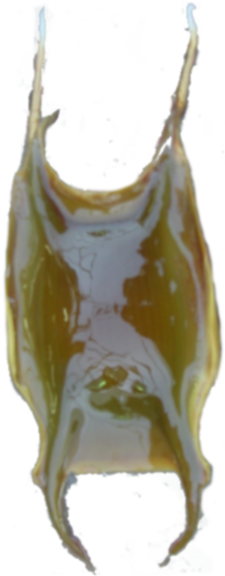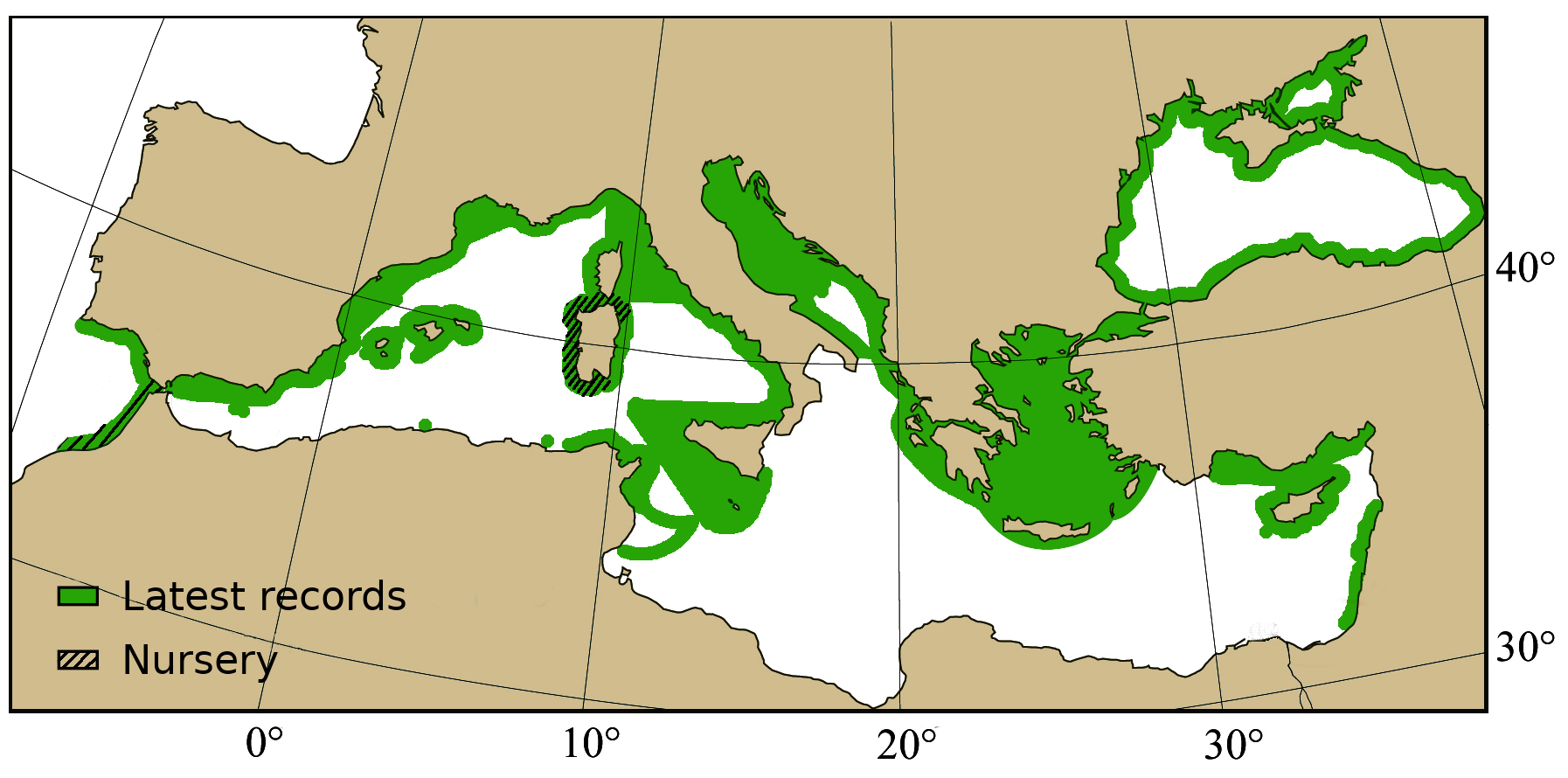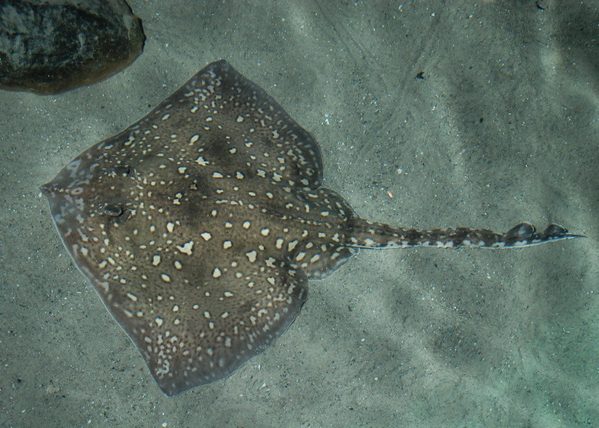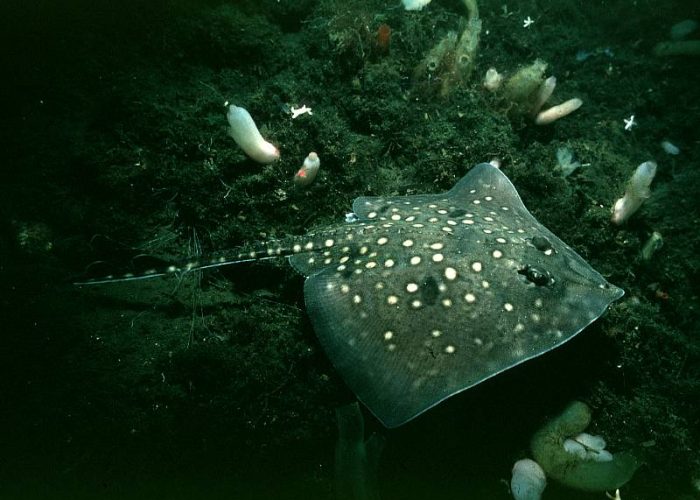Raja clavata
Common name: Thornback skate
Order: Rajiformes
Family: Rajidae
Synonyms: None
Misidentifications: None
Short description
Medium-sized skate. Angular disc with a circular body. Pectoral fins wider than long and with clear angles on the lateral side. Short rostrum, rounded at its extremity. Dorsally prickly in juveniles, adults with additional large thorns. A median row of 30-50 dark and light thorns from the nape to the first dorsal fin. Short and thick tail. Prickly margins on disc and undersite snout. Large females with prickly ventral surfaces.
Color: Highly variable with dorsal surface having all shades of brown with dark and light spots and blotches. Ventral surface white.
Measurements:
- Disk width (DW): up to 64 cm
- Total length (TL): up to 140 cm
- Weight: up to 5.2 kg
Swimming pattern: Undulatory and pelvic fin locomotion (walking and punting).
Egg case
Rectangular almost square in shape with stiff pointed horns at the corners deposited on shallow sand, mud, pebble or gravel bottoms. Rounded anterior apron and a straight. Posterior horns are short and sturdy, anterior thin and moderately long. Egg covered by fibres, adhesive fibres attached on lateral and pronounced keels.
Fresh color: from brown to amber, to yellowish in the edges.
Size: 5-9 cm length, 3.4-6.8 cm wide.
Distinctive features:

- Moderate eggs, rectangular/square in shape.
- Aprons and keels developed.
- Moderate and thin anterior horns. Short and sturdy posterior horns.
Raja: Long posterior horns. Anterior horns length less than twice the posterior.
Rajiformes / Rajidae: Rectangular egg-case, width no greater than twice the capsule length.
Biology / Ecology
Nocturnal species that feeds on crustaceans and fishes. In the North Sea, a clear annual cycle migration was observed with a distance ranging between 54-117 km per month. Adults can form sex-aggregations during mating season. Young are non-migratory, occurring in coastal nurseries.
Reproduction: Oviparous and polyandrous species. Size at maturity (TL): 60-85 cm female, 60-77 cm male at 7-8 years. Continuous spawner with some differences in the sexual cycle that may be explained by the water temperature and the impacts of the fishing pressure. The rate and peaks of egg deposition increase with the water temperature. Presents a high diversity of laying areas with a large bathymetric range (42-473 m around Sardinian, in the Central Western Mediterranean Sea) and sediment composition which may differ from the Atlantic Ocean. Eggs per year: to 170. Eggs per clutch: ~35. Embryonic development until hatching takes about 4-5 months. Size at birth (TL): 10-13 cm.
Habitat: Demersal coastal species, occurs on the shelf and upper slope. Inhabits a variety of substrates with a preference for sandy bottoms. Reported 5 to 1020 m deep (but more common between 10 m and 60 m). Tolerates low salinities.
Mainly misidentified with R. polystigma. Observations now often recorded as R. cf polystigma.
Distinguishing characteristics
- Snout bluntly pointed.
- Dorsally prickly in juveniles, adults with additional large thorns.
- Tail with light and dark crossbars.
Rajidae: Depressed body. Circular to rhombic disc. Tail well demarcated from disc.
Distribution
Worldwide: From Island and Norway in the North Sea, to the African Northwest. From South Africa to the Southwestern Indian Ocean. Present in Black Sea.
Mediterranean: Whole Mediterranean..
- Occurrence: Abundant.
- Latest records: Cyprus (2018-2022), Central-North Aegean Sea (2019), Gulf of Cadiz – Spain (2018), Gulf of Gabes – Tunisia (2017), Portugal (1986-2017), Atlantic – Morocco (2016), Sardinia (2016), Black Sea (2017), Adriatic Sea (2012-2015), Balearic Sea (2012-2015), Corsica – France (2012-2015), Greece (2012-2015), Italy (2012-2015), Gulf of Antalya – Turkey (2013), Marmara Sea (2013), Mersin bay – Turkey (2013), Lebanon (2012-2014), Iskenderebun bay (2010-2011), Edremit, Izmir, Saros and Sigacik bay – Turkey (2007-2009), Calabria – Italy (2007), Tunisia (2005), Algeria (2003-2004), Malta (2003).

Any recent observation not on the map?
Contact us!
Conservation
Threats: Taken as bycatch generally with trawlers. Commercial species in several areas of the Mediterranean (low commercial value).
Protection level:
- Global: Endangered (IUCN 2021, last assessment: 2019)
Key references
- Bilgin S., Hatice O. 2020. Spawning Period and Size at Maturity of the Thornback ray, Raja clavata (Linnaeus, 1758),(Elasmobranchii: Rajidae) in the Black Sea. Acta Aquatica Turcica 16(4): 525-534.
- Cabbar K., Yiğin C.Ç. 2021. Biology of the thornback ray (Linnaeus, 1758) in the North Aegean Sea. Oceanological and Hydrobiological Studies 50(2): 115-127.
- Carpentieri P., Nastasi A., Sessa M., Srour A. 2021. Incidental catch of vulnerable species in Mediterranean and Black Sea fisheries – A review. General Fisheries Commission for the Mediterranean. Studies and Reviews 101: I-317.
- Follesa M. C., Marongiu M. F., Zupa W., Bellodi A., Cau A., Cannas R., Colloca F., Djurovic M., Isajlovic I., Jadaud A., Manfredi C., Mulas A., Peristeraki P., Porcu C., Ramirez-Amaro S., Salmerón Jiménez F., Serena F., Sion L., Thasitis I., Cau A., Carbonara P. 2019. Spatial variability of Chondrichthyes in the northern Mediterranean. Scientia Marina 83(S1): 81-100.
- Kadri H., Marouani S., Saïdi B., Bradai M.N., Bouaïn A., Morize E. 2014. Age, growth, sexual maturity and reproduction of the thornback ray, Raja clavata (L.), of the Gulf of Gabès (south-central Mediterranean Sea). Marine Biology Research 10(4): 416-425.
- Marongiu M.F., Porcu C., Bellodi A., Cannas R., Cau A., Cuccu D., Mulas A., Follesa M.C. 2017. Temporal dynamics of demersal chondrichthyan species in the central western Mediterranean Sea: The case study in Sardinia Island. Fisheries Research 193: 81-94.
- O’Keefe M., Bengil EG., Palmer JL, Beton D, Çağlar Ç., Godley B.J, Özkan M., Snape R.T.E., Broderick A.C. 2023. Diversity and distribution of elasmobranchs in the coastal waters of Cyprus: using bycatch data to inform management and conservation. Front. Mar. Sci. 10: 1181437.
- Porcu C., Marongiu M.F., Bellodi A., Cannas R., Cau A., Melis R., Mulas A., Soldovilla G., Vacca L., Follesa M.C. 2017. Morphological descriptions of the eggcases of skates (Rajidae) from the central-western Mediterranean, with notes on their distribution. Helgoland Marine Research 71(1): 1-14.



